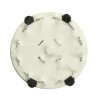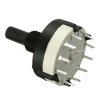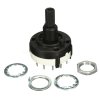So I am a bit uncertain on what type of switch to get. Each of the 8 detents need to be increments of 600 ohms, *or* compounding. Goal is to have one end outputting '0' ohms and the opposite end outputting approx 4.7k ohms. Each detent needs to decrease or increase by 600 ohms. So I am not sure if I am doing this correct. The resistance determines a certain Freq output. I have a 1-pole 12 position but maybe this is the incorrect switch........





